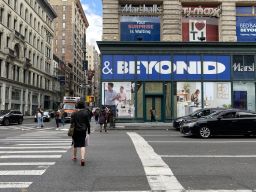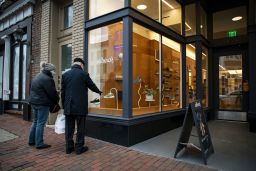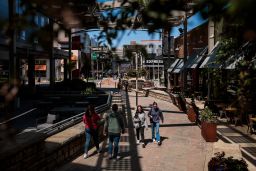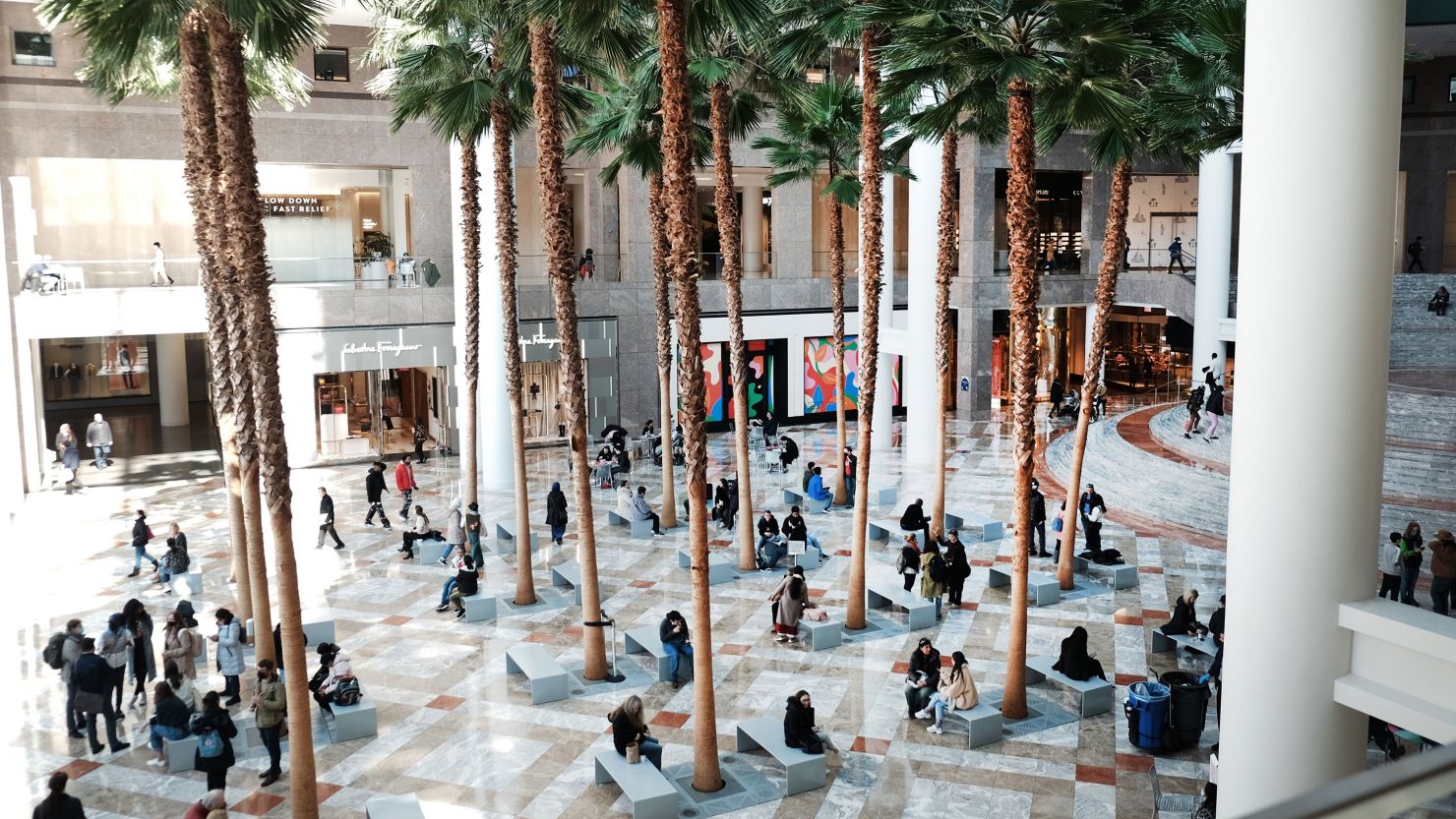Retail experts have long sounded the alarm on malls in the US.
But malls are not going extinct, they are merely adapting to a new environment. In fact, many have reported robust occupancy levels and bigger crowds than before the pandemic, according to a recent market analysis from Coresight Research.
In a report published in June, Coresight found foot traffic in top-tier malls was up by 12% in 2022 compared to 2019, while traffic in lower-tier malls was up 10%. The research firm defines “top-tier” centers as those located in affluent areas “where a typical shopper has an annual income of over $200,000” and which tend to feature newer brands and luxury retailers.
Between 2020 and 2022, these malls reported an annual growth rate of 5% with $7.5 billion in total revenue last year, according to the report. While lower-tier malls lagged slightly behind in revenue — reporting only $6.4 billion — they experienced a larger growth rate of nearly 9%.
On average, top-tier malls were more than 95% leased last year, while space in lower-tier malls in less-affluent regions were about 89% leased. Coresight found the numbers still lag slightly behind pre-pandemic levels, but remained promising.
“Occupancy rates are the No. 1 indicator of a mall’s health,” said the company’s CEO Deborah Weinswig, adding that any number above 92% is considered very good.
Brandon Isner, CBRE’s Head of Retail Research for the Americas, said occupancy rates of 100% are not necessarily a goal for malls looking to stay competitive and attractive, and store closures do not automatically mean the mall format is in trouble.
“For people who go to the malls, they’re going to want some fresh new stores every once in a while. Take into account the Bed Bath & Beyond retail space that’s being vacated as we speak – it’s turning out that’s actually kind of a good thing for retail,” he said. “The landlords are happy to get back those spaces because they can charge a higher rent. And for your retailers that might have wanted to get into those centers for a long time — because a lot of those are also located in great trade areas — this gives them an opportunity to enter the market.”
“Traffic is up and sales are up,” said Kirsten Lee, executive vice president and director of luxury leasing at Brookfield Properties, which manages more than 130 shopping centers across the US. “In many of our centers, we have a waiting list of tenants to get in.”
It’s not just Brookfield. Other high-end property developers like Macerich, Simon Property Group and Taubman Centers “have reported high demand for retail space in recent quarters,” Coresight found. Earlier this month, Tanger Outlets announced that its upcoming shopping center in Nashville, Tennessee, is already 95% leased.

A slight turnover in tenancy, helped by a small margin of unoccupied retail space, means properties can stay on top of trends and feature the most profitable retailers. “The mall should be a living breathing, organism,” said Weinswig. “And brands have their own life cycle.”
The specter of e-commerce
Over the past decade, the growth of e-commerce has incited fears that online shopping would ultimately replace the physical mall experience, particularly for a generation who grew up immersed in a digital landscape.
While e-commerce has been transformational, “the idea that it was going to kill brick and mortar retail didn’t take into account the entire equation,” said Isner.
The mall as a retail concept is alive and well, with retailers pivoting to fit the demands of a digital age. Rather than jostling with brick-and-mortar stores for supremacy, each shopping format is bolstering the other. Omnichannel marketing, where a brand has both a physical and online presence, has been a major factor driving mall growth, according to Coresight.

“Retailers today have that advantage where they can use digital solutions to build (their) brand rather than just throw stores everywhere like they did in the 70s, 80s and 90s,” said Isner. It means brands can be selective about where they open physical locations, and focus on top-tier malls with an energetic consumer base.
“We have a handful of brands that are opening up in the outlet space that were formally digitally native brands,” said Tanger Outlets CEO Stephen Yalof. He added that when brands open physical locations, customers go there to test the products, “and then you get to make a better choice when it’s time to actually make the purchase.”
Meanwhile, some digital-only brands have begun setting up shop in malls in order to expand their reach at a lower cost. Warby Parker, Allbirds and Wayfair are just a handful of online companies that have opened or announced that they will be opening conventional retail locations.

“These types of brands realize that they were spending more per customer in acquisition online than they were to build a brick-and-mortar store and have that experience for their customer in a major metro market,” said Lee.
A new generation of shoppers
Gen Z consumers are a huge market for retailers looking to stay relevant, according to analysts, and these shoppers are leading the charge in reviving the mall experience. A socially conscious generation acutely aware of climate change, Gen Z is also more likely to support brands prioritizing sustainability. According to June data from the ICSC, a retail trade organization, 56% of Gen Z shoppers “are willing to spend more to purchase sustainably sourced products.”
“A lot of luxury retailers are pretty environmentally conscious, or at least trying to overachieve in those areas and that can be attractive to the younger generations,” said Isner. “That can be an ‘in’ with regard to gaining new customers.”
Despite Gen Z having grown up with the internet at their fingertips, younger consumers are also consistent mallgoers.
“Social gets them in the door, but they’re not shopping online,” said Lee, noting that 78% of Gen Zers and 70% of Millennials follow luxury brands on social channels. “They are wanting an in-store luxury experience. They may have researched this product online but they want to go into a store, have a very knowledgeable sales staff help them and possibly even buy more while they’re there. That in-store experience is so critical.”

According to the ICSC, 73% of Gen Z shoppers said they visited a mall in the past month, compared to 65% of Millennials and 48% of Gen X respondents. But it’s not always to buy more stuff.
“There has been a rise in ‘experience-focused’ tenants in shopping malls that offer experiences like go-karting, trampolining, virtual reality, and arcades,” said ICSC vice president Stephanie Cegielski. “Many also offer food and drink, enabling visitors to be able to spend time together for longer periods without having to leave to grab a bite outside of the venue. On the other hand, entertainment operators can also help bring additional foot traffic to surrounding businesses, such as driving visitors to nearby restaurants after they finish playing.”
Almost two-thirds of Gen Z consumers also say they go to malls for the social aspect, not for any specific product, according to the ICSC. In 2020, shuttering stores spurred predictions that the pandemic would be the final nail in the mall’s coffin. But a post-pandemic society has proven hungry for communal spaces.
“Covid taught us that we are absolutely wired for community,” said Lee. “We have been doing this since the beginning of time, we want to be together. We have set up common areas of commerce for people to trade and meet, whether it was the town square or a bazaar.”
Properties offering high-end dining, shopping and entertainment activities will continue to be important retail spaces, according to Coresight. The mall continues to evolve and redefine its offerings but, for now at least, it is far from obsolete.




